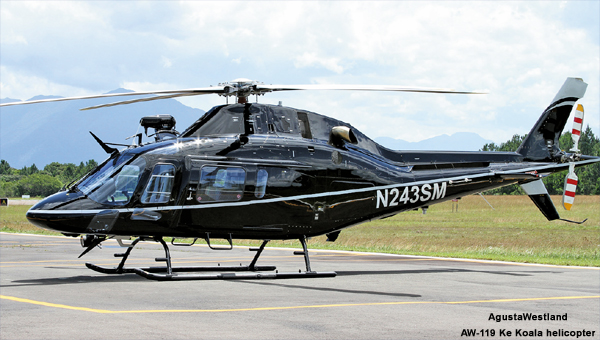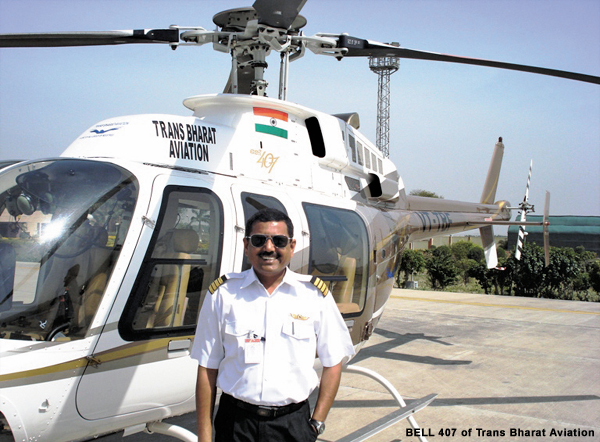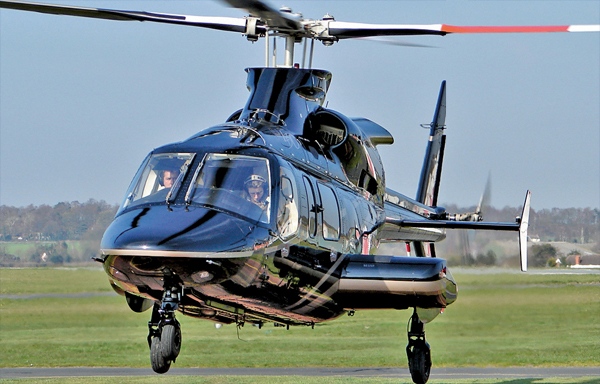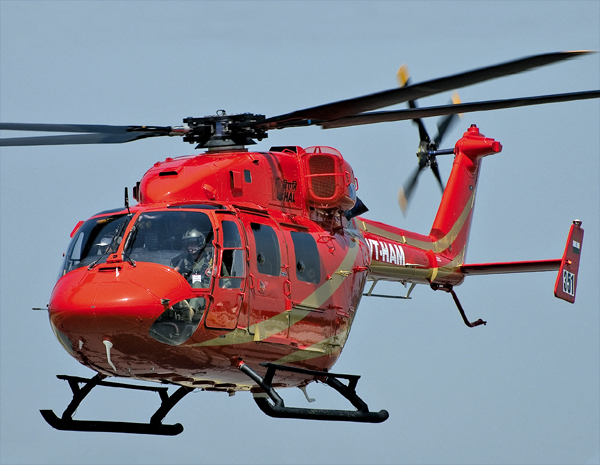|
The first real impetus to the civil helicopter
industry was provided in 1986 by the formation
of the Helicopter Corporation of India, which
later came to be known as Pawan Hans Helicopters
Limited (PHHL) and today holds and operates the
largest fleet of helicopters in the country. The
yearly growth in the industry up to 2006 remained
in single digits; mainly because of high cost
of operations and economic viability. However
despite these factors, the vibrant economic growth
saw the industry record a double digit growth
after 2006.Today, there are approximately 300
civil registered helicopters in the country, with
about 70 commercial operators and 36 maintenance
organisations. However, this number is woefully
inadequate when compared to the number of civil
helicopters seen worldwide. Also among the commercial
operators, there are only four to five big names
the rest being private or small time players.
As per the data available, helicopters in India
account for less than one per cent of the global
civil helicopters (35,000). A small country like
New Zealand has one helicopter per 7,000 people
whereas India has a ratio of 46 lakh people per
helicopter. In comparison in Brazil, a developing
country like ours, the city of Sao Paulo (similar
to Bombay and Delhi) itself has about 750 helicopters.
The United States a leader in the civil helicopter
market has approximately 14,000 helicopters, while
our neighbour China is reported to have about
1,200 helicopters.
Prospects
Global statistics on civil helicopter operations
world over indicate that 40 per cent of the civil
helicopter fleet is used for corporate aviation,
29 per cent for emergency medical services and
law enforcement, 16 per cent in the energy sector
for onshore/offshore operations, and the remaining
for operations in heli-tourism, adventure sports
and aerial surveys. A point worth noting is that
while 29 per cent of helicopters worldwide are
employed for law enforcement and emergency medical
services (EMS), these roles are practically non-existent
in India. Currently, a majority of the civil helicopters
in India are used in the energy sector, both onshore
and offshore, with the remaining being employed
for communications, corporate use, heli/religious
tourism, elections and surveys. 
Energy Sector/Offshore
Operations
Driven by the burgeoning demand for energy and
the ever-increasing price of crude oil, there
has been a hectic increase in offshore oil exploration
in recent times. Stake holders are today prepared
to commit large investments in offshore exploration
and production pushing into deep sea areas so
far untouched. Helicopters are an integral part
of and critical to such operations as they are
the umbilical cords to offshore platforms. In
fact, helicopters employed in offshore operations
worldwide account for a million flying hours a
year. In India, currently there are about 40 helicopters
employed in the offshore sector both on the Western
and Eastern coasts. These account for over 75
per cent of the total flying hours logged by the
civil helicopter fleet in the country. As oil
exploration moves further offshore, the demand
for modern helicopters with better range and advanced
safety features is bound to witness a marked increase.
Heli-Tourism
India’s diverse culture and geographic spread
coupled with a rich flora, fauna and wildlife,
make it one of the top heli- tourism destinations
in the world. The use of helicopters is convenient
and saves time for people travelling to remote
and far flung destinations especially in the mountains.
This has led to an increase in demand for civil
helicopters in this sector. Helicopter operators
such as Deccan Aviation, Global Vectra and PHHL
are already providing heli-tourism packages in
the North, South and Eastern parts of the country.
Although the tourism sector offers further scope
for growth of helicopters, their numbers have
not increased proportionately. The main reason
seems to be that presently most of the commercial
helicopter fleet is located at metro airports
and when chartered for heli-tourism, incurs heavy
positioning and maintenance costs. This combined
with lack of suitable infrastructure in terms
of proper helipads/communication facilities/safety
devices further act as a dampener. However, more
than any other aviation component helicopter operations
in this sector are driven by economic viability.
 Similarly,
India is a destination of great interest to religious
tourists. Journeys to Badrinath, Kedarnath, Vaishno
Devi and Amarnath which were difficult and time
consuming earlier, have now been made easier through
heli-pilgrimage services. On account of the emerging
popularity of religious tourism, the Ministries
of Civil Aviation and Tourism held a national
seminar on heli-tourism in October 2008, the first
of its kind to deliberate on steps to boost heli-tourism
in India. The main emphasis was on encouraging
heli-tourism and providing necessary support to
all operators by clearing the bottlenecks, identifying
profitable circuits and creating suitable infrastructure
in the areas identified. This was followed by
another National seminar on heli-tourism held
in Kerala on February 15, 2011 at Cochin International
airport. The aim of this seminar was to promote
heli-tourism and heli travel in Kerala and neighboring
states. Yet another seminar was conducted on this
subject by the Rotary Wing Society of India (RWSI)
at Trivandrum in Kerala on January 30, 2013 on
behalf of the Tourism Ministry of Kerala Government
with active participation of the Ministry of Civil
Aviation. Tourism is going to be a huge business
in India and this is one area the civil helicopter
Industry needs to focus on with due support from
the state/central governments. Similarly,
India is a destination of great interest to religious
tourists. Journeys to Badrinath, Kedarnath, Vaishno
Devi and Amarnath which were difficult and time
consuming earlier, have now been made easier through
heli-pilgrimage services. On account of the emerging
popularity of religious tourism, the Ministries
of Civil Aviation and Tourism held a national
seminar on heli-tourism in October 2008, the first
of its kind to deliberate on steps to boost heli-tourism
in India. The main emphasis was on encouraging
heli-tourism and providing necessary support to
all operators by clearing the bottlenecks, identifying
profitable circuits and creating suitable infrastructure
in the areas identified. This was followed by
another National seminar on heli-tourism held
in Kerala on February 15, 2011 at Cochin International
airport. The aim of this seminar was to promote
heli-tourism and heli travel in Kerala and neighboring
states. Yet another seminar was conducted on this
subject by the Rotary Wing Society of India (RWSI)
at Trivandrum in Kerala on January 30, 2013 on
behalf of the Tourism Ministry of Kerala Government
with active participation of the Ministry of Civil
Aviation. Tourism is going to be a huge business
in India and this is one area the civil helicopter
Industry needs to focus on with due support from
the state/central governments.
Shuttle Services
The requirement for helicopters for shuttle services
is also growing especially in the Northeast due
to the nature of terrain and the rigorous road
journeys involved. A number of commercial operators
are already providing services on contractual
basis in the North-Eastern states such as Arunachal
Pradesh, Sikkim, Meghalaya, Tripura and Nagaland.
In fact, helicopters are also providing inter-island
transportation for Andaman & Nicobar and Lakshadweep
for administration as well as tourism promotion.
With a number of international airports located
far away from the centre in cities like Bangalore,
Hyderabad, Chennai and Simla, heli-shuttle requirements
are bound to see a rapid increase. However, suitable
infrastructure and regulatory issues will have
to be put in place to make it possible for helicopters
to operate smoothly without any bottlenecks.
Helicopter Emergency Medical
Services (HEMS)
Medical attention within the golden hour increases
the chances of a patient’s survival and recovery.
A helicopter equipped with emergency medical equipment
along with a qualified medic can play a crucial
role in these operations. While this concept is
widely prevalent in the West, in India it is yet
to take-off. The HEMS concept is a necessity and
needs to be implemented at the earliest- the lead
needs to be taken by the Government. The ONGC
is the only organisation in India which has converted
its Dauphin helicopter for HEMS role in Bombay
High. After a seminar held in Bangalore in November
2010, it was decided to introduce the HEMS concept
first in remote and mountainous areas with the
support of the concerned state governments. To
encourage this concept, there is a requirement
by the government to offer subsidies in order
to reduce the cost of operations.

Disaster Management
Since the early 1960s, military helicopters have
rendered yeoman service in the management of disasters
such as floods and earthquakes in India. In September
2011, the earthquake in Sikkim saw for the first
time civil helicopters taking part in the relief
and rescue operations alongside the IAF helicopters.
In the integrated effort for disaster management,
civil helicopters available in the particular
state should be included in the planning process
for relief operations. These helicopters suitably
equipped/modified can effectively supplement the
efforts undertaken by the armed forces.
Law Enforcement
Present day law enforcement is varied and intricate
and needs more than routine policing to deter
unlawful activity. ‘Aerial Law Enforcement’ (ALE)
is a force multiplier and plays a dominant role
in augmenting the strength of the law agencies.
The helicopter due to its inherent characteristics
and ability to perform a wide range of missions
is ideally suited for this role. The New York
City Police Department Aviation Bureau became
the first law enforcement agency in the world
to operate a helicopter in1948. Public acceptance
of law enforcement helicopter operations grew
from then on as technology developments made them
safer and more efficient. Today the US has over
3,000 helicopters operated by more than 400 law
enforcement agencies covering 46 States. In India
the concept of aerial law enforcement by the police
and allied agencies is still in a nascent stage.
However, a beginning has been made with the Parliament
Standing Committee on transport, tourism and culture
in their latest report recommending the expansion
of existing helicopter roles to disaster management
and law & order enforcement, thus accepting the
need at the highest level of the government. The
use of civil registered helicopters being used
in anti naxal operations in the red corridor is
a recent step in this direction though riddled
with many problems. The helicopters being employed
belong to companies holding non-scheduled operations
permit like the Pawan Hans and Global Vectra.
Even helicopters belonging to the Border Security
Force are being flown with operational and maintenance
services provided by Pawan Hans. However these
are adhoc measures and need to be streamlined
along with the regulatory nuances.
Police being a state subject, the states would
have to play a key role in establishing ALE agencies/police
aviation wings. This needs to be first implemented
in major metros like Bombay, Delhi, Bangalore,
Chennai, etc and thereafter gradually expand to
other areas. However, the states on their own
may be reluctant to implement this programme due
to costs involved. The centre will have to play
a major role in terms of providing monetary, logistical
and operational support to the states for establishing
police aviation wings.
Future Trends
As per reports, the rotorcraft industry in India
is poised to grow at the rate of 10 to 12 per
cent annually. The usage of helicopters in the
energy sector, especially in the onshore sector,
is likely to double in the coming years. Major
helicopter operators are expanding their fleets
to meet the increased demand for corporate and
leisure travel. Development of infrastructure
in metros for helicopter operations is likely
to see a boost in terms of heliports, roof-top
helipads and heli-corridors. The government is
considering inviting 100 per cent foreign direct
investment (FDI) in setting up helicopter services
in India. This will be a positive step to enhance
commercial employment of helicopters. The use
of helicopters for public good is likely to increase
substantially especially in respect of HEMS, law
enforcement, disaster management as well as transportation
in remote areas. The use of civil helicopters
for law enforcement in anti-naxal operations is
already a reality and likely to increase further.
There is also a vast scope for using suitably
equipped helicopters for fire-fighting especially
in high-rise buildings in metros. Power line washing,
another area where helicopters can play a vital
role resulting in rich dividends by way of reduction
in transmission losses. The concept has already
been tried out in India by the Power Grid Corporation
with PHHL, and is likely to pick up in the future.
Sensing this growth, a number of major helicopter
manufacturers are establishing bases in India
by establishing joint ventures with Indian companies.
These include AgustaWestland, Sikorsky, Eurocopter
and Bell.
Operational & Fiscal Bottlenecks
 The
rising costs of aviation turbine fuel (ATF), customs
duty for import of helicopters/spares and application
of fixed-wing air traffic rules to helicopters
have stymied the growth of civil helicopter industry
to a large extent. Lack of suitable infrastructure
is another major problem. While the scope of operations
and utilisation for commercial helicopters is
vast, the requisite infrastructure is almost non-existent
both in the metros and remote areas. We have to
look at a network of Heliports and Roof top helipads
if the full potential of civil helicopter operations
in India is to be realised. With the civil helicopter
industry expanding, the demand for pilots is increasing.
While 80 per cent of pilots flying in the civil
sector are erstwhile officers from the armed forces,
there is a need to enhance training facilities
to get pilots from among civilians. Simulator
training on helicopters is woefully inadequate
with only a single facility in Bangalore as a
result of a joint venture of HAL with CAE of Canada,
catering to Bell 412, Dauphin and Dhruv helicopters.
Similar facilities need to come in the northern
and eastern regions of the country. The
rising costs of aviation turbine fuel (ATF), customs
duty for import of helicopters/spares and application
of fixed-wing air traffic rules to helicopters
have stymied the growth of civil helicopter industry
to a large extent. Lack of suitable infrastructure
is another major problem. While the scope of operations
and utilisation for commercial helicopters is
vast, the requisite infrastructure is almost non-existent
both in the metros and remote areas. We have to
look at a network of Heliports and Roof top helipads
if the full potential of civil helicopter operations
in India is to be realised. With the civil helicopter
industry expanding, the demand for pilots is increasing.
While 80 per cent of pilots flying in the civil
sector are erstwhile officers from the armed forces,
there is a need to enhance training facilities
to get pilots from among civilians. Simulator
training on helicopters is woefully inadequate
with only a single facility in Bangalore as a
result of a joint venture of HAL with CAE of Canada,
catering to Bell 412, Dauphin and Dhruv helicopters.
Similar facilities need to come in the northern
and eastern regions of the country.
The biggest bottleneck appears to be the applicability
of fixed-wing regulations to helicopter operations.
Fortunately, based on the recommendations of the
Parliamentary Committee on Aviation, the requirement
for looking into helicopter operations in a holistic
manner is being pursued on fast track. There is
a need for clearing regulatory bottlenecks faced
by the industry to enhance growth and facilitate
operations. As a first step, it has been decided
to have separate corridors for operation of helicopters
in Delhi and Mumbai airspace- this aspect has
already been put into practice. This will enhance
safety as well as efficiency and capacity for
helicopter operations. However despite these impediments,
on account of its terrain and size, India offers
phenomenal potential for usage of civil helicopters
for public good.
|